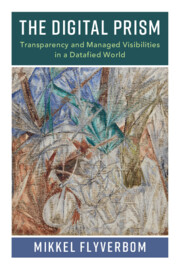Book contents
- The Digital Prism
- The Digital Prism
- Copyright page
- Contents
- Acknowledgments
- Introduction: The Transparency Formula
- 1 Digital and Datafied Spaces
- 2 Transparency and Managed Visibilities
- 3 People under Scrutiny
- 4 Organizations Gone Transparent
- 5 Seeing the World
- Conclusion: Life in the Digital Prism
- Bibliography
- Index
2 - Transparency and Managed Visibilities
Published online by Cambridge University Press: 27 September 2019
- The Digital Prism
- The Digital Prism
- Copyright page
- Contents
- Acknowledgments
- Introduction: The Transparency Formula
- 1 Digital and Datafied Spaces
- 2 Transparency and Managed Visibilities
- 3 People under Scrutiny
- 4 Organizations Gone Transparent
- 5 Seeing the World
- Conclusion: Life in the Digital Prism
- Bibliography
- Index
Summary
Media and other technologies make new forms of human action possible, and they do so not only as devices of information, but also as “agencies of order” (Peters, 2015). Such ordering effects are well described and well theorized in existing research on the societal consequences of media and digital technologies. What is less pronounced is that digital transformations have consequences for how our attention is guided, both as individuals and as organizations and societies. That is, they make us see, know and govern in new ways, and shape what we think of as reality. To explore these issues, it may be useful to return to insights from earlier thinking that articulated the relationship between media and human realities and how mediations shape social life. At the advent of modern journalism and news media, Lippmann (1922) reminded us that media put “pictures in our heads.” Such pictures condition how humans act on the world, and to study the power of media, Lippmann suggested, we need to articulate how such special interests come to control our view of the world (Turner, 2014). These issues are still salient today, where new types of corporations are taking up roles that are comparable to those of media conglomerates of the past. Not only are tech companies taking over large parts of social infrastructures and becoming the primary spaces for social interaction and entry points for news and other societally important forms of information.
- Type
- Chapter
- Information
- The Digital PrismTransparency and Managed Visibilities in a Datafied World, pp. 39 - 58Publisher: Cambridge University PressPrint publication year: 2019



